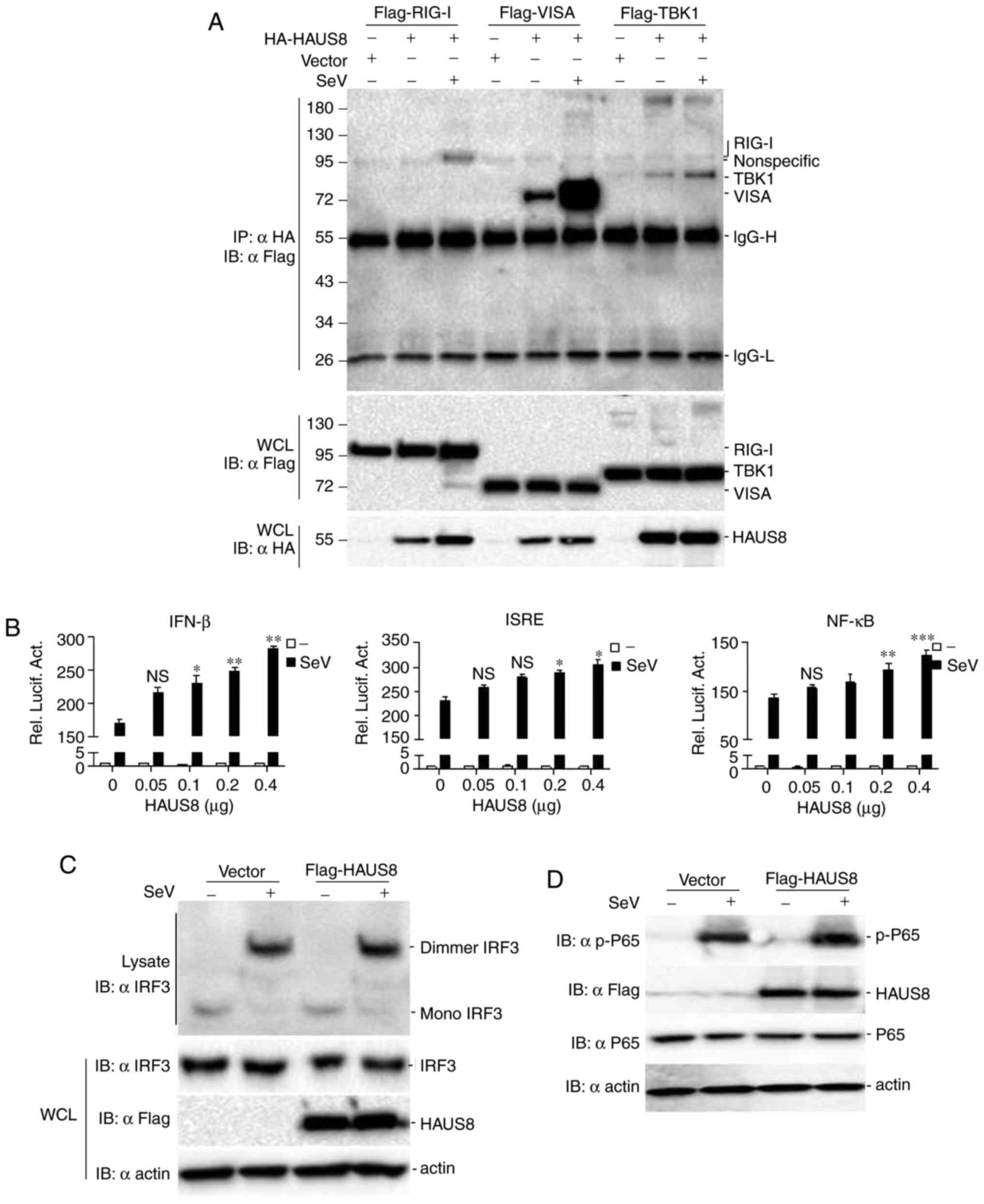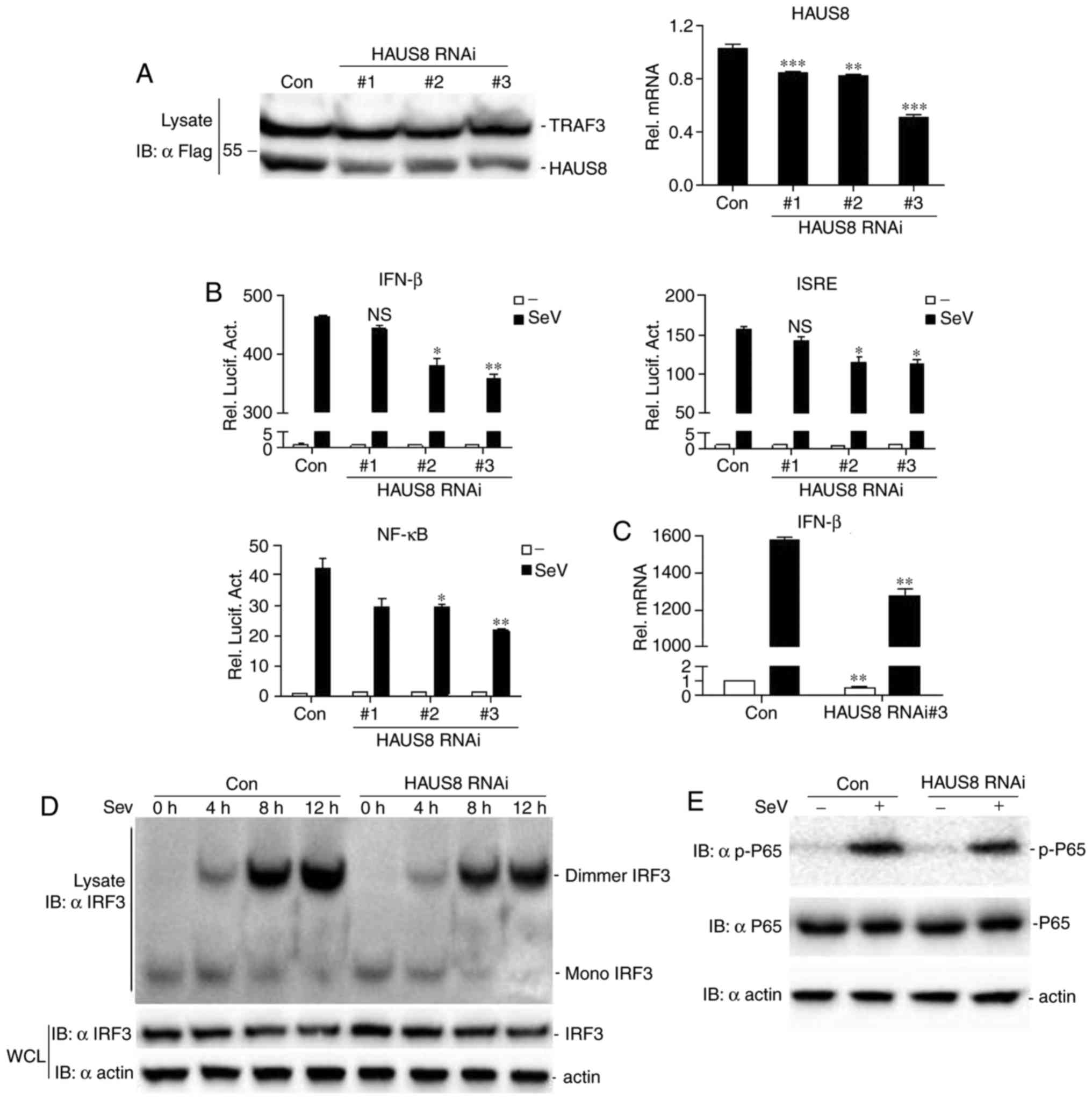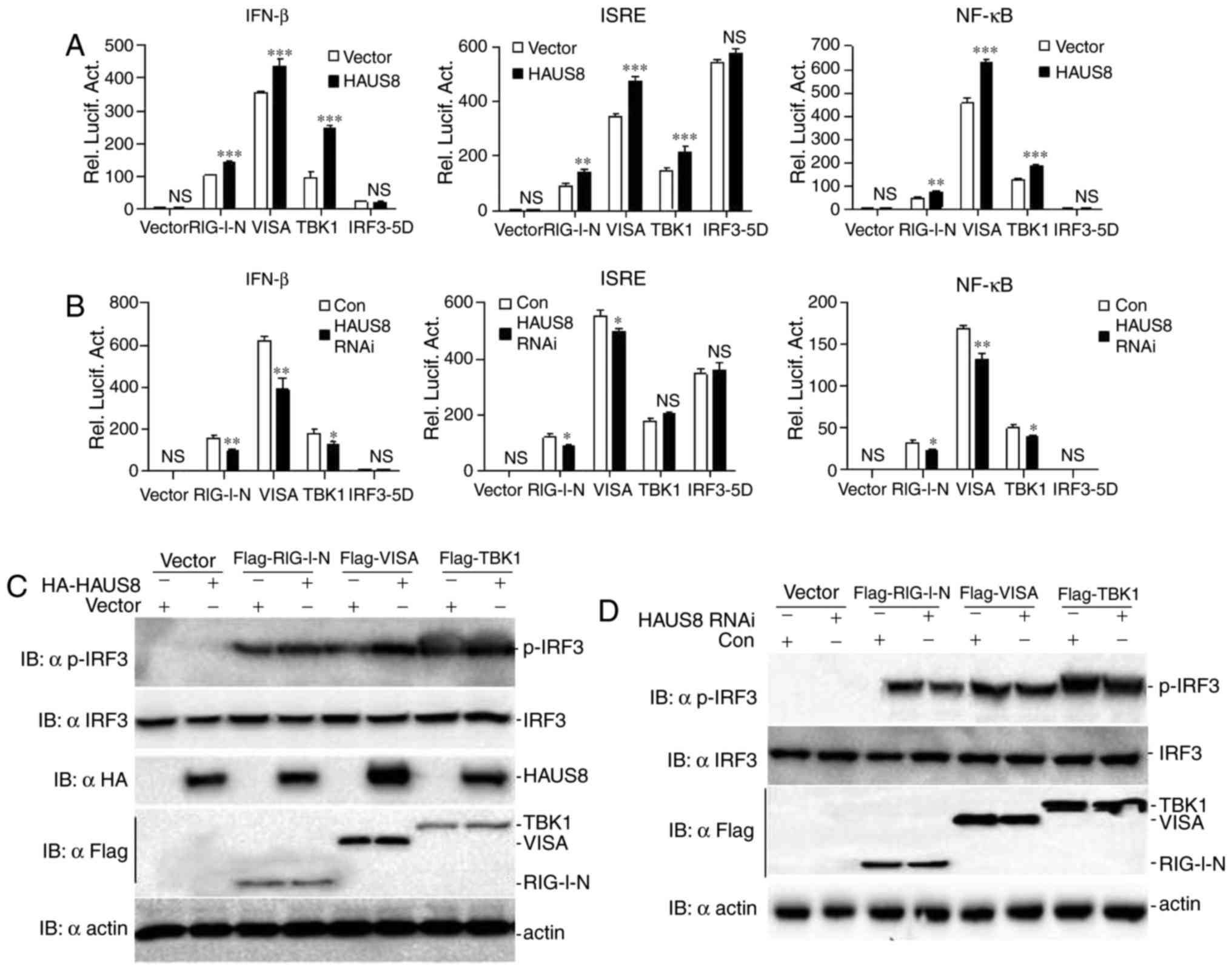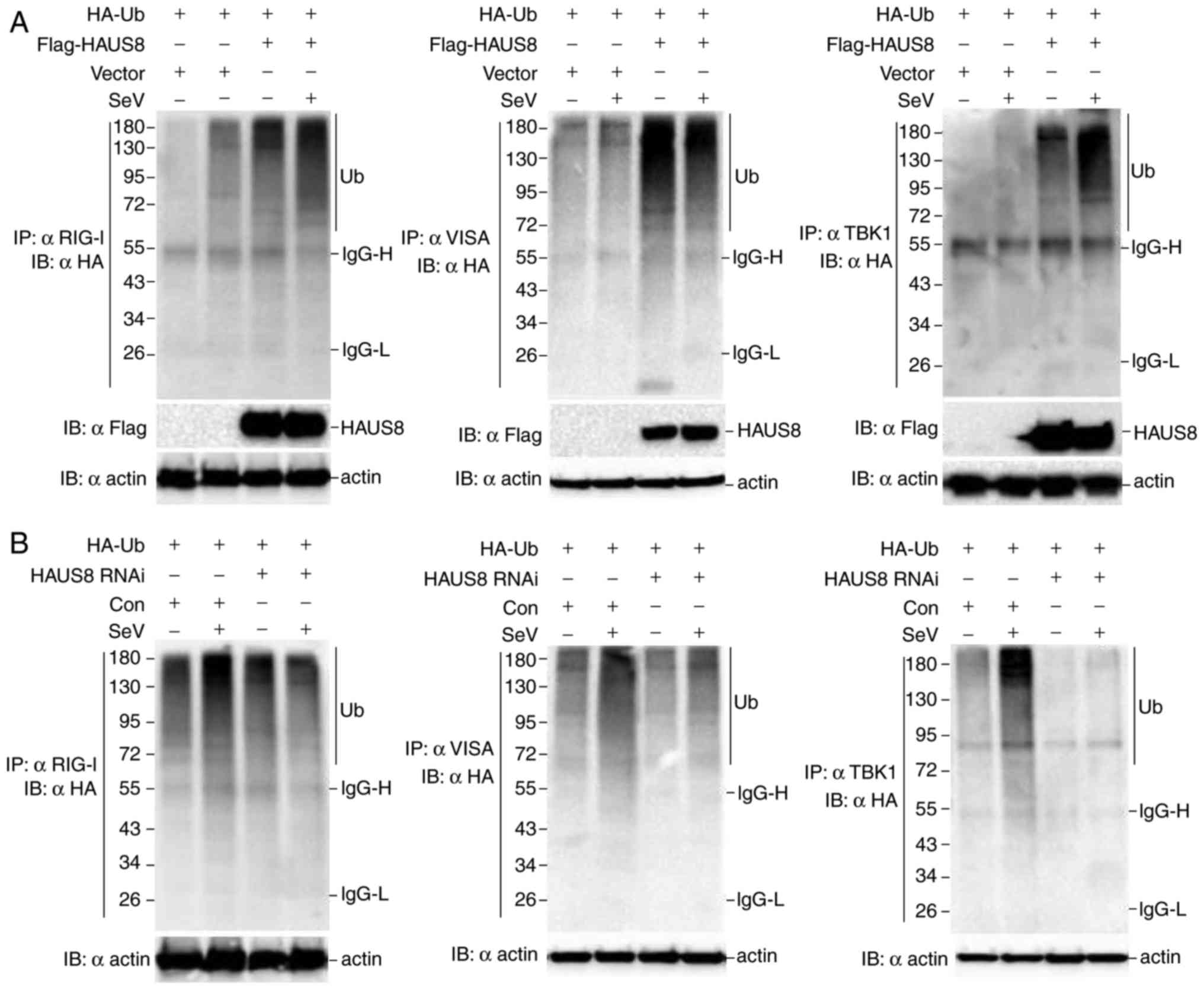|
1
|
Yoneyama M, Kikuchi M, Natsukawa T,
Shinobu N, Imaizumi T, Miyagishi M, Taira K, Akira S and Fujita T:
The RNA helicase RIG-I has an essential function in double-stranded
RNA-induced innate antiviral responses. Nat Immunol. 5:730–737.
2004. View
Article : Google Scholar : PubMed/NCBI
|
|
2
|
Kato H, Sato S, Yoneyama M, Yamamoto M,
Uematsu S, Matsui K, Tsujimura T, Takeda K, Fujita T, Takeuchi O
and Akira S: Cell type-specific involvement of RIG-I in antiviral
response. Immunity. 23:19–28. 2005. View Article : Google Scholar : PubMed/NCBI
|
|
3
|
Kato H, Takeuchi O, Sato S, Yoneyama M,
Yamamoto M, Matsui K, Uematsu S, Jung A, Kawai T, Ishii KJ, et al:
Differential roles of MDA5 and RIG-I helicases in the recognition
of RNA viruses. Nature. 441:101–105. 2006. View Article : Google Scholar : PubMed/NCBI
|
|
4
|
Pichlmair A, Schulz O, Tan CP, Näslund TI,
Liljeström P, Weber F and Sousa Reis e C: RIG-I-mediated antiviral
responses to single-stranded RNA bearing 5′-phosphates. Science.
314:997–1001. 2006. View Article : Google Scholar : PubMed/NCBI
|
|
5
|
Hornung V, Ellegast J, Kim S, Brzózka K,
Jung A, Kato H, Poeck H, Akira S, Conzelmann KK, Schlee M, et al:
5′-Triphosphate RNA is the ligand for RIG-I. Science. 314:994–997.
2006. View Article : Google Scholar : PubMed/NCBI
|
|
6
|
Takeuchi O and Akira S: Pattern
recognition receptors and inflammation. Cell. 140:805–820. 2010.
View Article : Google Scholar : PubMed/NCBI
|
|
7
|
Goubau D, Deddouche S and Sousa Reis e C:
Cytosolic sensing of viruses. Immunity. 38:855–869. 2013.
View Article : Google Scholar : PubMed/NCBI
|
|
8
|
Xu LG, Wang YY, Han KJ, Li LY, Zhai Z and
Shu HB: VISA is an adapter protein required for virus-triggered
IFN-beta signaling. Mol Cell. 19:727–740. 2005. View Article : Google Scholar : PubMed/NCBI
|
|
9
|
Seth RB, Sun L, Ea CK and Chen ZJ:
Identification and characterization of MAVS, a mitochondrial
antiviral signaling protein that activates NF-kappaB and IRF 3.
Cell. 122:669–682. 2005. View Article : Google Scholar : PubMed/NCBI
|
|
10
|
Meylan E, Curran J, Hofmann K, Moradpour
D, Binder M, Bartenschlager R and Tschopp J: Cardif is an adaptor
protein in the RIG-I antiviral pathway and is targeted by hepatitis
C virus. Nature. 437:1167–1172. 2005. View Article : Google Scholar : PubMed/NCBI
|
|
11
|
Kawai T, Takahashi K, Sato S, Coban C,
Kumar H, Kato H, Ishii KJ, Takeuchi O and Akira S: IPS-1, an
adaptor triggering RIG-I- and Mda5-mediated type I interferon
induction. Nat Immunol. 6:981–988. 2005. View Article : Google Scholar : PubMed/NCBI
|
|
12
|
Jacobs JL and Coyne CB: Mechanisms of MAVS
regulation at the mitochondrial membrane. J Mol Biol.
425:5009–5019. 2013. View Article : Google Scholar : PubMed/NCBI
|
|
13
|
Belgnaoui SM, Paz S and Hiscott J:
Orchestrating the interferon antiviral response through the
mitochondrial antiviral signaling (MAVS) adapter. Curr Opin
Immunol. 23:564–572. 2011. View Article : Google Scholar : PubMed/NCBI
|
|
14
|
Wu G, Lin YT, Wei R, Chen Y, Shan Z and
Lee WH: Hice1, a novel microtubule-associated protein required for
maintenance of spindle integrity and chromosomal stability in human
cells. Mol Cell Biol. 28:3652–3662. 2008. View Article : Google Scholar : PubMed/NCBI
|
|
15
|
Zhong B, Yang Y, Li S, Wang YY, Li Y, Diao
F, Lei C, He X, Zhang L, Tien P and Shu HB: The adaptor protein
MITA links virus-sensing receptors to IRF3 transcription factor
activation. Immunity. 29:538–550. 2008. View Article : Google Scholar : PubMed/NCBI
|
|
16
|
Gietz RD, Schiestl RH, Willems AR and
Woods RA: Studies on the transformation of intact yeast cells by
the LiAc/SS-DNA/PEG procedure. Yeast. 11:355–360. 1995. View Article : Google Scholar : PubMed/NCBI
|
|
17
|
Chenuet S, Martinet D, Besuchet-Schmutz N,
Wicht M, Jaccard N, Bon AC, Derouazi M, Hacker DL, Beckmann JS and
Wurm FM: Calcium phosphate transfection generates mammalian
recombinant cell lines with higher specific productivity than
polyfection. Biotechnol Bioeng. 101:937–945. 2008. View Article : Google Scholar : PubMed/NCBI
|
|
18
|
Livak KJ and Schmittgen TD: Analysis of
relative gene expression data using real-time quantitative PCR and
the 2(-Delta Delta C(T)) method. Methods. 25:402–408. 2001.
View Article : Google Scholar : PubMed/NCBI
|
|
19
|
Robitaille AC, Mariani MK, Fortin A and
Grandvaux N: A high resolution method to monitor
phosphorylation-dependent activation of IRF3. J Vis Exp: e53723.
2016. View Article : Google Scholar
|
|
20
|
Yamamoto M, Sato S, Hemmi H, Hoshino K,
Kaisho T, Sanjo H, Takeuchi O, Sugiyama M, Okabe M, Takeda K and
Akira S: Role of adaptor TRIF in the MyD88-independent toll-like
receptor signaling pathway. Science. 301:640–643. 2003. View Article : Google Scholar : PubMed/NCBI
|
|
21
|
Fields S and Song O: A novel genetic
system to detect protein-protein interactions. Nature. 340:245–246.
1989. View
Article : Google Scholar : PubMed/NCBI
|
|
22
|
Maniatis T, Falvo JV, Kim TH, Kim TK, Lin
CH, Parekh BS and Wathelet MG: Structure and function of the
interferon-beta enhanceosome. Cold Spring Harb Symp Quant Biol.
63:609–620. 1998. View Article : Google Scholar : PubMed/NCBI
|
|
23
|
Silverman N and Maniatis T: NF-kappaB
signaling pathways in mammalian and insect innate immunity. Genes
Dev. 15:2321–2342. 2001. View Article : Google Scholar : PubMed/NCBI
|
|
24
|
Hiscott J, Grandvaux N, Sharma S, Tenoever
BR, Servant MJ and Lin R: Convergence of the NF-kappaB and
interferon signaling pathways in the regulation of antiviral
defense and apoptosis. Ann N Y Acad Sci. 1010:237–248. 2003.
View Article : Google Scholar : PubMed/NCBI
|
|
25
|
Yoneyama M, Suhara W and Fujita T: Control
of IRF-3 activation by phosphorylation. J Interferon Cytokine Res.
22:73–76. 2002. View Article : Google Scholar : PubMed/NCBI
|
|
26
|
Gack MU, Shin YC, Joo CH, Urano T, Liang
C, Sun L, Takeuchi O, Akira S, Chen Z, Inoue S and Jung JU: TRIM25
RING-finger E3 ubiquitin ligase is essential for RIG-I-mediated
antiviral activity. Nature. 446:916–920. 2007. View Article : Google Scholar : PubMed/NCBI
|
|
27
|
Oshiumi H, Matsumoto M, Hatakeyama S and
Seya T: Riplet/RNF135, a RING finger protein, ubiquitinates RIG-I
to promote interferon-beta induction during the early phase of
viral infection. J Biol Chem. 284:807–817. 2009. View Article : Google Scholar : PubMed/NCBI
|
|
28
|
Yan J, Li Q, Mao AP, Hu MM and Shu HB:
TRIM4 modulates type I interferon induction and cellular antiviral
response by targeting RIG-I for K63-linked ubiquitination. J Mol
Cell Biol. 6:154–163. 2014. View Article : Google Scholar : PubMed/NCBI
|
|
29
|
Kuniyoshi K, Takeuchi O, Pandey S, Satoh
T, Iwasaki H, Akira S and Kawai T: Pivotal role of RNA-binding E3
ubiquitin ligase MEX3C in RIG-I-mediated antiviral innate immunity.
Proc Natl Acad Sci USA. 111:5646–5651. 2014. View Article : Google Scholar : PubMed/NCBI
|
|
30
|
Wang Y, Tong X and Ye X: Ndfip1 negatively
regulates RIG-I-dependent immune signaling by enhancing E3 ligase
Smurf1-mediated MAVS degradation. J Immunol. 189:5304–5313. 2012.
View Article : Google Scholar : PubMed/NCBI
|
|
31
|
Jia Y, Song T, Wei C, Ni C, Zheng Z, Xu Q,
Ma H, Li L, Zhang Y, He X, et al: Negative regulation of
MAVS-mediated innate immune response by PSMA7. J Immunol.
183:4241–4248. 2009. View Article : Google Scholar : PubMed/NCBI
|
|
32
|
Castanier C, Zemirli N, Portier A, Garcin
D, Bidère N, Vazquez A and Arnoult D: MAVS ubiquitination by the E3
ligase TRIM25 and degradation by the proteasome is involved in type
I interferon production after activation of the antiviral
RIG-I-like receptors. BMC Biol. 10:442012. View Article : Google Scholar : PubMed/NCBI
|
|
33
|
Song G, Liu B, Li Z, Wu H, Wang P, Zhao K,
Jiang G, Zhang L and Gao C: E3 ubiquitin ligase RNF128 promotes
innate antiviral immunity through K63-linked ubiquitination of
TBK1. Nat Immunol. 17:1342–1351. 2016. View
Article : Google Scholar : PubMed/NCBI
|
|
34
|
Li S, Wang L, Berman M, Kong YY and Dorf
ME: Mapping a dynamic innate immunity protein interaction network
regulating type I interferon production. Immunity. 35:426–440.
2011. View Article : Google Scholar : PubMed/NCBI
|
|
35
|
Wang C, Chen T, Zhang J, Yang M, Li N, Xu
X and Cao X: The E3 ubiquitin ligase Nrdp1 ‘preferentially’
promotes TLR-mediated production of type I interferon. Nat Immunol.
10:744–752. 2009. View
Article : Google Scholar : PubMed/NCBI
|
|
36
|
Cui J, Li Y, Zhu L, Liu D, Songyang Z,
Wang HY and Wang RF: NLRP4 negatively regulates type I interferon
signaling by targeting the kinase TBK1 for degradation via the
ubiquitin ligase DTX4. Nat Immunol. 13:387–395. 2012. View Article : Google Scholar : PubMed/NCBI
|
|
37
|
Zhang M, Wang L, Zhao X, Zhao K, Meng H,
Zhao W and Gao C: TRAF-interacting protein (TRIP) negatively
regulates IFN-β production and antiviral response by promoting
proteasomal degradation of TANK-binding kinase 1. J Exp Med.
209:1703–1711. 2012. View Article : Google Scholar : PubMed/NCBI
|
|
38
|
Chiang C and Gack MU: Post-translational
control of intracellular pathogen sensing pathways. Trends Immunol.
38:39–52. 2017. View Article : Google Scholar : PubMed/NCBI
|
|
39
|
Chen C, Weisz OA, Stolz DB, Watkins SC and
Montelaro RC: Differential effects of actin cytoskeleton dynamics
on equine infectious anemia virus particle production. J Virol.
78:882–891. 2004. View Article : Google Scholar : PubMed/NCBI
|
|
40
|
Sodeik B: Mechanisms of viral transport in
the cytoplasm. Trends Microbiol. 8:465–472. 2000. View Article : Google Scholar : PubMed/NCBI
|
|
41
|
Bozym RA, Delorme-Axford E, Harris K,
Morosky S, Ikizler M, Dermody TS, Sarkar SN and Coyne CB: Focal
adhesion kinase is a component of antiviral RIG-I-like receptor
signaling. Cell Host Microbe. 11:153–166. 2012. View Article : Google Scholar : PubMed/NCBI
|
|
42
|
Chiang HS, Zhao Y, Song JH, Liu S, Wang N,
Terhorst C, Sharpe AH, Basavappa M, Jeffrey KL and Reinecker HC:
GEF-H1 controls microtubule-dependent sensing of nucleic acids for
antiviral host defenses. Nat Immunol. 15:63–71. 2014. View Article : Google Scholar : PubMed/NCBI
|
|
43
|
Ohman T, Rintahaka J, Kalkkinen N,
Matikainen S and Nyman TA: Actin and RIG-I/MAVS signaling
components translocate to mitochondria upon influenza A virus
infection of human primary macrophages. J Immunol. 182:5682–5692.
2009. View Article : Google Scholar : PubMed/NCBI
|


















